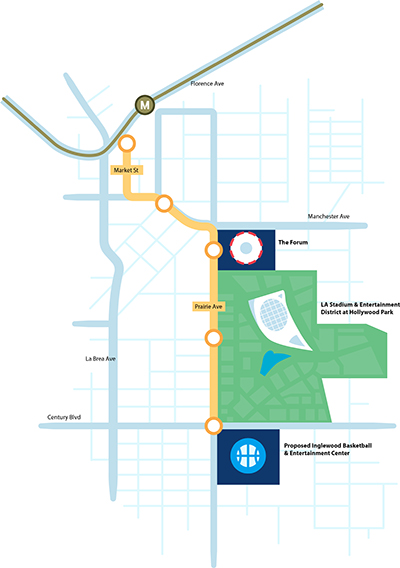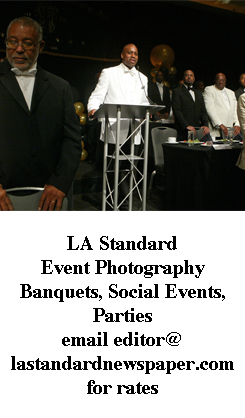Mayor Butts highlights the financial impact of recent development projects, and addresses the traffic concerns.

By Jason Lewis
As Inglewood’s Hollywood Park is transforming into a mega sports and entertainment complex, and with the revitalization of downtown, there is one question that Mayor James T. Butts routinely gets.
“With all of that happening, you know the only thing that people ask me, ‘what about the traffic?’” he said.
Before Butts spoke about the traffic concerns and remedies during a public scoping meeting at the Inglewood Senior Center, which took place on July 26, he spoke about all of the great things that are happening in the city.
“In 2014, we said that we’re going to reopen the Forum,” he said. “The conventional wisdom said that people weren’t going to come to Inglewood for concerts again. Well as of today, the Forum is the No. 1 grossing concert venue in the state of California, No. 2 in the country, and No. 3 in the world.”
Butts worked for the Inglewood Police Department from 1972 to 1991, and then he left to become the Chief of Police in Santa Monica. He returned as the Mayor of Inglewood in 2011.
“When I left Inglewood in 1991, we were home of the Lakers and the Kings,” he said. “The racetrack did about 43,000 people a day, six days a week. And the Forum did about 50-60 concerts a year. And we were known as the City of Champions. We also had a Sizzler and a big donut. When I came back in 2011, all we had was a Sizzler and a big donut.”
The Forum reopened in 2015, and the city began to negotiate with the Rams and the NFL around that time.
“Once again, the conventional wisdom was that the NFL would never come to Inglewood, we’re just a stalking horse for St. Louis (where the Rams played at the time), and the NFL was just playing with us,” Butts said. “In January of 2016, 30 of the 32 owners voted to allow the Rams to build what was then a $2.8 billion stadium, now it’s a $4 billion stadium, in the city of Inglewood, and for the Rams to return here in 2020. In January of 2017, the Chargers, who had a competing plan in Carson, asked if they could come to Inglewood as well. In June of 2017, we entered into an exclusive negotiation agreement with the Clippers for them to build a state-of-the-art NBA arena, their corporate headquarters, a practice facility, and a couple hundred thousand square feet of open space for the residents.”
Butts went on to say that the Girl Scouts will be moving their regional headquarters from Marina Del Rey to Inglewood. The Los Angeles Philharmonic’s youth orchestra will relocate to Inglewood, and the NFL Network, which is based in Culver City, is coming to town. The 2022 Super Bowl and 2023 NCAA football national championship game will be held at the new football stadium. Also at the stadium, the city is in negotiations with FIFA to host a World Cup soccer match in 2016, and the 2028 Summer Olympic games will open there.
After stating all of the activity in Inglewood, Butts addressed the traffic concerns, pointing out that there was not much traffic after the Lakers and Kings left for Staples Center.
“What did we do without the traffic?” he asked. “This is what we did without the traffic. Our property values plummeted. Unemployment reached 17-and-a-half percent. We were about seven months away from cash flow bankruptcy when I took office in February of 2011. We were down to our last $11 million, and we were burning on the average $50,000 a day more than we were taking in in revenues. So that’s what we did without the traffic.”
Butts also spoke about the traffic issues when the Lakers and Kings played at the Forum.
“People tend to forget that when the Lakers, Kings, and the Forum was going, we’d have 43,000 people in outbound traffic against 16,758 inbound for a Lakers game at rush-hour, and we got along just fine,” he said.
Butts pointed out that most of the traffic for the football games will be on Sundays, which is not a peak traffic day. He also spoke about the influx of traffic when Santa Monica became a tourist destination during his time working there, and how it actually had a positive impact on the city.
“I spent 15 years in Santa Monica, and we became an international tourist destination,” he said. “They actually had a higher crime rate than the city of Inglewood when I got there. We got to the point where, on a summer weekend, we had 400,000 people come through town. But in Santa Monica, the general fund quadrupled. The beautiful thing about that is that the people who don’t live here pay for your services, and that’s the objective.”
Most cities that become prominent by luring professional sports teams take on the massive costs of building stadiums and arenas, but that’s not the case in Inglewood.
“Most cities, to secure an NFL franchise, they bond anywhere from $300 million to $600 million that is paid for out of anticipated revenues from the stadium,” Butts said. “Or they give land of equal value. This city did neither for this deal. There is no city money proposed or involved in the proposed Clipper arena.”
The Rams, Chargers, and Clippers have not played a game in Inglewood yet, but the city is already benefitting from these plans.
“We had a 17-and-a-half percent unemployment rate when I took office,” Butts said. “As of this month, it’s down to 4.8 percent. We have written into all of our developmental agreements our local hire goals. Our local hire goals are 35 percent. We also have goals for the contracting of women-led and minority-led, disadvantaged-led businesses. In 2017, $166 million of construction subcontracts went to women-led and minority-led subcontractors for the stadium project. This series of projects will produce 50,000 jobs of various durations over the next seven years, and 12,000 permanent jobs, ranging from entry level to supervisory management and executive management levels when the development is fully populated.”
When the sports and entertainment complex is complete, there will be an NFL stadium, a 300-room hotel, movie theater, 800,000 square feet of office space, a 6,000-seat performing arts center, 900,000 square feet of retail and fine dining, four public parks of 26 acres, 2,000 residential units, and two lakes.
“This development will be the catalyst for the total renovation of the city,” Butts said. “We are building an economic infrastructure so that our children, when they return from college, can work and raise families in the city that they grew up in, and not have to go elsewhere to do it.”
While Butts gave a glowing report on the city’s growth, the traffic concern still remains. To address this problem, the City of Inglewood is developing a proposal for an automated people mover system called the Inglewood Transit Connector.
Lisa Trifiletti, principal of Trifiletti Consulting and Inglewood Transit Connector (ITC) Project Manager, gave a presentation on the proposed automated people mover system that would be designed to connect the city’s new activity centers directly to downtown Inglewood and the Metro regional rail system.
“Metro has made a huge investment in expanding public transit options with the Metro Green and Crenshaw/LAX lines, both bringing benefits to Inglewood and the region,” she said. “But we still need a direct rail connection to the stadium and the entertainment district. The ITC project will make that critical connection. It’s designed to keep visitors on the Metro system, keep them out of their cars, and keep them out of nearby neighborhoods”
Trifiletti said that Metro performed a preliminary analysis of the area to see if they could develop a spur line off of the Crenshaw line that would come into the city. Metro determined that it was not feasible for them to build a rail line, and that it would be more beneficial for the city to build an independent automated people mover, similar to the system that many airports have.
“We started with the route options Metro originally analyzed, and then we refined them to make sure they reflected community goals,” Trifiletti said. “We looked at various routes and combinations including Century Boulevard, Arbor Vitae, Prairie, Market Street and Manchester Boulevard. Of all the alternatives analyzed, two routes had the highest potential ridership: Century Boulevard and Market Street. While there were pros and cons to all of the options, the Market Street/Prairie alignment had the fewest drawbacks and the most potential benefits.”
The elevated automated people mover system would provide residents and visitors with a world-class transit connection to-and-from the Metro Crenshaw/LAX Line, and directly to the city’s major activity centers including downtown Inglewood, The Forum, the Los Angeles Stadium and Entertainment District at Hollywood Park, and the proposed Inglewood Basketball and Entertainment Center.
This is the only option that would link downtown to the sports and entertainment complex.
“Market Street is in the midst of going through an exciting transformation,” Trifiletti said. “It makes a lot of sense to locate a station there where it would connect downtown to a growing transit network and contribute to the positive changes already underway.”
This proposed plan would cover 1.8 miles, which is the shortest distance of all of the routes that were considered, and it would be the least expensive. It would be elevated to avoid traffic concerns of a street level rail system, and it would be too costly to build it underground. The goal would be to have electric powered cars to improve the air quality by keeping cars off of the road.
“We’re looking at world-class cities, and our goal is to create a transit system that delivers world-class service and convenience.” Trifiletti said.
The city is looking to engage the community as this plan progresses.
“We are committed to public involvement,” Trifiletti said. “Throughout the process we’re going to be seeking your comments and feedback. We’re going to look to have project design workshops in the fall, and we’ll be working with folks throughout the process to make sure that our project is fully responsive to community issues.”
For more information about this project, visit www.envisioninglewood.org and sign up for their email list to stay up to date.











